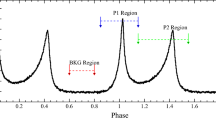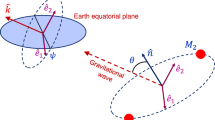Abstract—
Instrumentation for observing occultations of stars by Solar System bodies and its parameters are described. The complex is designed for observations at the AZT-2 telescope (D = 70 cm, F = 10.5 m) of the Main Astronomical Observatory of the National Academy of Sciences of Ukraine (МAO NASU); it is equipped with an optical reducer of the focal length and may also be mounted at the other telescopes. The observation complex uses the Apogee Alta U47 CCD camera as a light receiver, which operates in the drift scan mode. The results of the study of two phenomena that were observed with this complex are described. During the observations on September 21, 2018, a decrease of approximately 0.04m in the brightness of the star HD 45314 was detected near the ephemeris moment of occultation by comet 21P/Giacobini−Zinner. This value exceeds the level of errors possible in the photometry of a stellar track. A possible explanation of this effect by the attenuation of light in a symmetrical dust coma of the comet was analyzed. It has been shown that this factor cannot yield the required magnitude of the light attenuation. The observed decrease in brightness is explained by the passage of the star through the jet structure with sharp boundaries, the optical thickness of which is 0.035 ± 0.012 and the opening angle is 54.6°. The single scattering albedo of dust particles in this jet is in the range of 0.04−0.06. The occultation of the star UCAC4-475-051755 by asteroid (259) Alethea was recorded on March 31, 2019, and it lasted for 16.7 s. This occultation duration corresponds to the asteroid chord 185 km long, while the expected one is 61 km, and it exceeds a value of 179 km accepted for this asteroid diameter. This difference is explained by the ellipsoidal shape of asteroid (259) Alethea, and the grounds for a value of 1 : 1.19 for its axial ratio are presented.












Similar content being viewed by others
REFERENCES
V. Karbovs’kii, V. Kleshchonok, and M. Buroms’kii, “Software and hardware complex for observation of star occultations by asteroids,” Bull. T. Shevchenko Nat. Univ. of Kyiv, No. 2 (56), 41–44 (2017).
R. Andrae, M. Fouesneau, O. Creevey, Ch. Ordenovic, N. Mary, A. Burlacu, L. Chaoul, A. Jean-Antoine-Piccolo, G. Kordopatis, A. Korn, Y. Lebreton, Ch. Panem, B. Pichon, F. Thévenin, G. Walmsley, and C. A. L. Bailer-Jones, “Gaia Data Release 2. First stellar parameters from Apsis,” Astron. Astrophys. 61, A8 (2018).
F. Braga-Ribas, B. Sicardy, J. L. Ortiz, et al., “A ring system detected around the Centaur (10199) Chariklo,” Nature 508, 72–75 (2014).
B. Carry, “Density of asteroids,” Planet. Space Sci. 73 (1), 98–118 (2012).
E. Chornaya, E. Zubko, I. Luk’yanyk, A. Kochergin, M. Zheltobryukhov, O. Ivanova, G. Kornienko, A. Matkin, A. Baransky, I. Molotov, V. Sharoshchenko, and G. Videen, “Imaging polarimetry and photometry of comet 21P/Giacobini-Zinner,” Icarus 337, 471 (2020).
J. Clairemidi, G. Moreels, and V. A. Krasnopolsky, “Gaseous CN, C2, and C3 jets in the inner coma of Comet P/Halley observed from the Vega 2 spacecraft,” Icarus 86, 115–128 (1990).
J. L. Elliot, E. Dunham, and D. Mink, “The rings of Uranus,” Nature 267, 328–330 (1977).
Y. R. Fernández, D. D. Wellnitz, M. W. Buie, et al., “The inner coma and nucleus of comet Hale-Bopp: Results from a stellar occultation,” Icarus 140, 205–220 (1999).
L. Kolokolova, M. S. Hanner, A.-C. Levasseur-Regourd, and B. E. S. Gustafson, “Physical properties of cometary dust from light scattering and thermal emission,” in Comets II, Ed. by M. Festou, H. U. Keller, and H. A. Weaver (Univ. of Arizona Press, Tucson, Ariz., 2005), pp. 577–604.
S. M. Larson and M. F. A’Hearn, “Comet Bowell (1980b) — Measurement of the optical thickness of the coma and particle albedo from a stellar occultation,” Icarus 58, 446–450 (1984).
S. M. Larson and Z. Sekanina, “Coma morphology and dust-emission pattern of periodic Comet Halley. I — High-resolution images taken at Mount Wilson in 1910,” Astron. J. 89, 571–578 (1984).
M. E. Lawler and D. E. Brownlee, “CHON as a component of dust from comet Halley,” Nature 359, 810–812 (1992).
L. A. Lebofsky and J. R. Spencer, “Radiometry and thermal modeling of asteroids,” in Asteroids II, Ed. by R. P. Binzel (Univ. of Arizona Press, Tucson, Ariz., 1989), p. 128.
F. Marchis, M. Kaasalainen, E. F. Y. Hom, J. Berthier, J. Enriquez, D. Hestroffer, D. Le Mignant, and I. de Pater, “Shape, size and multiplicity of main-belt asteroids: I. Keck Adaptive Optics survey,” Icarus 185, 39–63 (2006).
J. R. Masiero, A. K. Mainzer, T. Grav, J. M. Bauer, R. M. Cutri, J. Dailey, P. R. M. Eisenhardt, R. S. McMillan, T. B. Spahr, M. F. Skrutskie, D. Tholen, R. G. Walker, E. L. Wright, E. DeBaun, D. Elsbury, T. Gautier IV, S. Gomillion, and A. Wilkins, “Main belt asteroids with WISE/NEOWISE. I. Preliminary albedos and diameters,” Astrophys. J. 741, 68 (2011).
J. Pittichova, C. E. Woodward, M. S. Kelley, and W. T. Reach, “Ground-based optical and Spitzer infrared imaging observations of comet 21P/Giacobini–Zinner,” Astron. J. 136, 1127–1136 (2008).
P. Pravec, A. W. Harris, and B. D. Warner, “Asteroid photometry opportunities,” Minor Planet Bull. 29, 19 (2002).
V. K. Rosenbush, “Opposition effects in brightness, color, and polarization of comet 1P/Halley: Comparison with atmosphereless Solar System bodies,” Sol. Syst. Res. 39, 312–321 (2005).
E. L. Ryan, F. Usui, D. Kuroda, T. G. Muller, S. Hasegawa, M. Ishiguro, T. Ootsubo, D. Ishihara, H. Kataza, S. Takita, S. Oyabu, M. Ueno, H. Matsuhara, and T. Onaka, “Asteroid catalog using Akari: AKARI/IRC mid-infrared asteroid survey,” Publ. Astron. Soc. Jpn. 63, 1117–1138 (2011).
E. L. Ryan and C. E. Woodward, “Rectified asteroid albedos and diameters from IRAS and MSX photometry catalogs,” Astron. J. 140, 933–943 (2010).
N. N. Samus’, E. V. Kazarovets, O. V. Durlevich, N. N. Kireeva, and E. N. Pastukhova, “General catalogue of variable stars: Version GCVS 5.1,” Astron. Rep. 61, 80–88 (2017).
P. Tanga and M. Delbo, “Asteroid occultations today and tomorrow: Toward the GAIA era,” Astron. Astrophys. 474, 1015–1022 (2007).
E. F. Tedesco, P. V. Noah, M. C. Noah, and S. D. Price, IRAS Minor Planet Survey. NASA Planetary Data System, IRAS-A-FPA-3-RDR-IMPS-V6.0 (2004).
N. Zacharias, C. T. Finch, T. M. Girard, A. Henden, J. L. Bartlett, D. G. Monet, and M. I. Zacharias, “The Fourth US Naval Observatory CCD Astrograph Catalog (UCAC4),” Astron. J. 145, 44 (2013).
ACKNOWLEDGMENTS
We are grateful to A.R. Baranskii for providing us with the images of comet 21P/Giacobini−Zinner, which he acquired on September 20, 2018, at the Lesniki Observation Station, and V.I. Shavlovskii for the given opportunity to perform test observations with the complex at the AZT-2 telescope.
Author information
Authors and Affiliations
Corresponding authors
Additional information
Translated by E. Petrova
About this article
Cite this article
Kleshchonok, V.V., Karbovsky, V.L., Buromsky, M.I. et al. Observation of Stellar Occultations by Asteroid (259) Alethea and Comet 21P/Jacobini−Zinner. Kinemat. Phys. Celest. Bodies 37, 41–51 (2021). https://doi.org/10.3103/S0884591321010025
Received:
Revised:
Accepted:
Published:
Issue Date:
DOI: https://doi.org/10.3103/S0884591321010025




